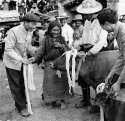Inspired by China, Panasonic gets back to its innovative roots
Company finds founding philosophy of 'constant change' embodied by Chinese division
TOKYO -- is expanding its presence in the vast Chinese market through an ethos of "constant change" -- the same approach it taught China 40 years ago, but now it is the Japanese company learning from its former pupil.
The electronics giant is building a new plant to manufacture home appliances in China, the company's first such investment in 16 years, bucking the growing trend among global manufacturers to shift production out of China amid a bitter trade war with the U.S.
Despite slowing growth of China's consumer electronics market, Panasonic believes its in-house China & Northeast Asia Company will be able to achieve strong sales growth in a market with great breadth and depth, which the company expects to be a center of innovation that will rival the U.S. in the future.
On April 1, Tetsuro Homma, a Panasonic director, was in Beijing to attend a ceremony to launch the in-house company. In giving a pep talk to local employees, Homma encouraged them to share their true thoughts. "Let it all out," he said.
Wearing a sweater, Homma came across like the founder of a Chinese tech startup and delivered a 40-minute speech in Chinese to inspire the audience, gesticulating with his hands. His message was clear: The in-house company will to all intents and purposes be a Chinese company, not just an overseas unit of a Japanese corporation. "From this day on, we will pursue Chinese speed, Chinese cost and Chinese style."
Homma was trying to translate the order he had received from Panasonic President and CEO Kazuhiro Tsuga into words that would strike a chord with the employees. In setting up a task force to create the new company in July 2018, Tsuga instructed, "Make another Panasonic in China."
Through his frequent trips to China, Tsuga had become convinced that Panasonic's future growth would depend on its growth in the country.
...
Homma's career-long involvement in the company's Chinese operations has its origins in Matsushita's meeting with Deng, the architect of China's economic reform.
On joining the company, then called Matsushita Electric Industrial, in 1985, Homma was chosen as a trainee to become a China expert under a special training program created by the founder. Homma spent nearly three years struggling with the Chinese language. After studying from morning to night at the company's training center in Osaka for nearly a year, he was transferred to Taiwan, where he spent the first year attending a Chinese language school, and then worked for the firm's local office for another year.
Homma was the leader of the task force to set up the new unit. The team of 40, including Chinese employees, discussed the mission for eight weeks.
When encouraged to open up, the Chinese employees started airing complaints and grievances about misguided and ill-conceived instructions from the headquarters in Japan.
The company's 85 locations in China are all seen as mere outposts of business units in Japan. They have been incapable of keeping up with the changing trends in the Chinese market, missing out on many business opportunities as a result.
Since the beginning of his latest stint in China in April, Homma has been visiting Panasonic's local offices in various parts of the country to hold lunch meetings with middle-ranking Chinese employees aged around 40 to listen to what they have to say.
When he promises them that he will not tell anybody what he hears at the meetings, the Chinese employees often take the opportunity to voice their complaints with relish.
As he has visited about 20 local offices in China, Homma has heard some of the same questions come up many times, such as, "Why do Japanese make new components whenever they develop a new product?"
Panasonic's Japanese engineers design each new product from scratch, whether it is for the Japanese or the Chinese market, developing new parts with their traditional spirit of craftsmanship.
When adopted in China, this approach makes it difficult to secure parts in time. The company also demands cuts in production costs, effectively creating a mission-impossible situation for Chinese employees.
In another episode about why Panasonic needs to do more to tailor its products to the Chinese market, Homma was surprised to find that a new product to be launched in China carried such a low price tag. When he asked the reason why it could be sold so cheaply, a Chinese engineer said one feature that was popular in Japan had been removed. When Homma asked the engineer whether that was the right move to make, the reply was that the feature had no appeal to Chinese consumers.
The Chinese engineer also said he had been silent on what he really thought out of consideration and respect for Japanese engineers, as well as concern about possible effects on his position within the company. "Since you have urged us to let out our thoughts, I have taken the plunge," he told Homma.
Homma was stunned by what the engineer told him, but was also pleased, as he thought he was seeing a sign of change for the better.
Homma has opened an account on Weibo, China's leading microblogging site, and frequently posts about his business experiences in the country.
On holidays, he often visits historical sites with employees to show his commitment to learning about Chinese culture. All these efforts are aimed at changing the mindset of Chinese employees who see their workplaces as mere outposts of business units in Japan.


